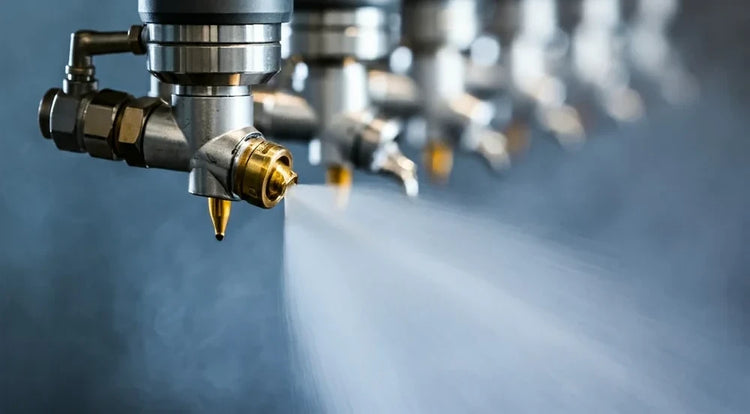Car Wash Pre-Soak Spray Nozzles
Pre-soak is the foundation of an effective wash cycle. The right spray nozzles wet the surface fast, penetrate road film, and lay down chemistry evenly so the high-pressure stage can lift dirt with less time and water. NozzlePro supplies durable, chemically compatible nozzles and accessories optimized for tunnel, rollover/in-bay automatic, and self-serve systems.

Why the Right Nozzle Matters
-
Coverage & Cling: Uniform droplet distribution creates a continuous film for better dwell and chemistry activation.
-
Chemistry Efficiency: Even application reduces over-use of detergents and pre-soak agents.
-
Cycle Speed: Correct flow and angle shorten dwell/soak time without sacrificing results.
-
Lower Operating Cost: Optimized flow rates cut water, energy, and chemical consumption.
Typical Pre-Soak Setups
-
Arch / Manifold Bars: Multiple flat-fan or full-cone tips spaced to create continuous overlap across vehicle width and height.
-
Pivoting or Oscillating Heads: Increase agitation and reach into contours and wheel wells.
-
Foam Pre-Soak / Curtain: Air-assisted atomizing to create rich foam where branding and visual cueing matter.
Recommended Nozzle Types
-
Flat-Fan Nozzles (40°–110°): Primary choice for arches; excellent sheet coverage and overlap.
-
Full-Cone Nozzles: Thicker, penetrating spray for heavy soils or increased standoff distance.
-
Air-Atomizing / Dry-Fog Tips: Fine droplets or foam for visual coverage and chemical activation at low flow.
-
Solid-Stream / Cluster Jets: Targeted impact on wheel faces, rocker panels, and bug-heavy zones.
Materials: Stainless steel or PVDF/PP with Viton®/EPDM seals for alkaline detergents and road-film removers.
Selection & Sizing Guide
-
Define Flow & Pressure:
-
Typical pre-soak: 20–80 PSI (1.4–5.5 bar) and 1–5 GPM (3.8–19 L/min) per tip, depending on bay width and chemistry.
-
-
Choose Pattern & Angle:
-
Arches: 65°–110° flat-fan at 8–18" (200–450 mm) standoff for overlap (50–70%).
-
Long standoff or windy bays: consider full-cone for heavier droplets.
-
-
Spacing & Overlap:
-
Center-to-center spacing ≈ 0.6–0.8 × standoff; verify on-surface coverage without gaps.
-
-
Chemistry Compatibility:
-
Confirm wetted materials with your detergent SDS.
-
-
Maintenance:
-
Install inline strainers (60–100 mesh) and quick-disconnects to simplify changeout.
-
Schedule inspection to replace worn tips that drift out of spec.
-
Best Practices
-
Stage the Chemistry: Apply bottom-up for cling, then top-down to flood remaining surfaces.
-
Dial Droplet Size: Finer droplets increase surface area; heavier droplets resist drift.
-
Use Check Valves: Prevent siphoning and drips that streak finishes.
-
Calibrate Quarterly: Measure actual flow vs. nameplate—replace tips outside ±10% of target.
-
Winterization: Purge lines and use anti-freeze protocols to protect tips and manifolds.
Common Issues & Fixes
-
Striping or Missed Areas: Increase overlap, adjust angles, or add one nozzle between gaps.
-
Excess Chemical Use: Reduce orifice size/pressure, verify dwell time, add foamers where appropriate.
-
Premature Corrosion: Move to 316 SS or chemical-resistant polymers; upgrade seals.
-
Drift/Mist in Windy Bays: Switch to lower-angle flat-fans or full-cones; shorten standoff.
Suggested NozzlePro Products
-
Flat-Fan Series for arches (40°/65°/80°/110°), SS or polymer bodies
-
Full-Cone Nozzles for distance and penetration
-
Air-Atomizing / Foam Nozzles for visual coverage and chemistry activation
-
Inline Strainers & Check Valves to protect tips and stop drips
-
Quick-Connect Adapters for rapid service
(Ask us for the exact SKU/orifice code based on your pump curve and desired GPM.)
Specs We’ll Ask For
-
Bay type (tunnel, in-bay automatic, self-serve)
-
Arch width / standoff distance
-
Pump pressure & available flow
-
Chemistry type and target dwell time
-
Climate/wind exposure and water quality
FAQ
What spray angle should I use on a pre-soak arch?
80°–110° flat-fan at 8–18" standoff is common. Use wider angles for close mounting and tighter fans for long standoff or windy conditions.
How often should I replace tips?
Inspect monthly; replace when flow deviates more than ±10% from spec or pattern shows edge wear.
Do I need foam?
Foam improves visibility and cling, helpful for branding and dwell, but not strictly required. Air-assisted tips enable foam at lower water use.
What filtration is recommended?
60–100 mesh upstream of each bank/manifold. If sediment is an issue, add a coarser pre-filter before the pump.
Get Application Help
Our team will size the orifice, pattern, and spacing for your arch and chemistry.
-
📞 +1 650.375.7002

